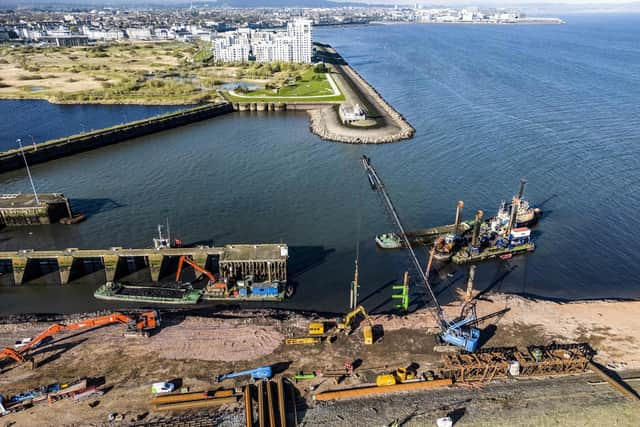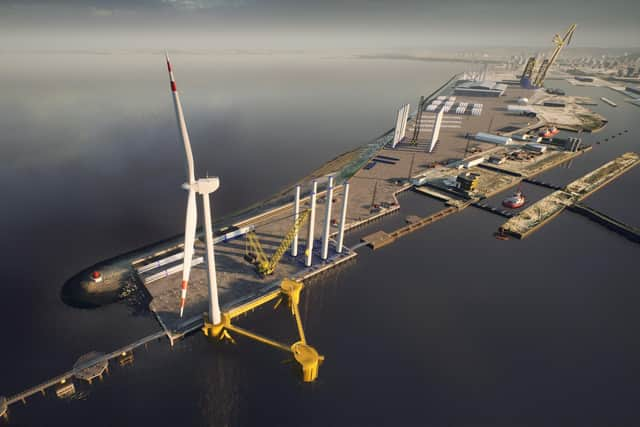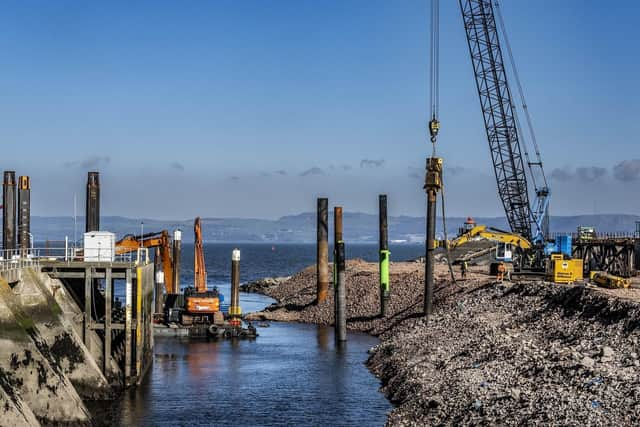Edinburgh's new Leith renewables hub will be at centre of development of new wind farms in North Sea
and live on Freeview channel 276
In just over a year's time, Leith is set to be at the centre of operations to build massive wind turbines in the North Sea to help power homes, factories and offices across the UK.
Construction is well under way on a huge renewables hub, covering 175 acres of land at Leith docks, where the giant-sized components which make up the next generation of wind farms will be brought and assembled before being shipped to the designated sites for installation. Forth Ports is investing £50m in the hub, which includes a vast marshalling area and a new outer berth needed for the enormous ships which will transport the turbines. The hub – the largest in Scotland – is expected to support up to 1,000 high-quality, long-term direct jobs and another 2,000 indirect jobs.
Advertisement
Hide AdAdvertisement
Hide AdThe outer berth, being created immediately outside the port’s lock gates, will be capable of accommodating the world’s largest wind turbine installation vessels, which are about one and a half times the length of a football pitch and slightly narrower, with a lifting capacity of around 2,000 tonnes. They’re too big to enter the docks, but the new outer berth will allow them to be loaded up with turbines – in three or four sections, each as tall as the Scott Monument – along with the blades and other parts of the turbine. Once they reach the site of the wind farm, it will take the vessels a day or two to install each turbine.


Also investing in the new facilities are UK energy giant BP and German partners EnBW, who won a joint bid to establish the Morven wind farm, 60 kilometres off the Scottish coast. The 860 square kilometres of seabed in the North Sea awarded to BP/EnBW was one of 17 sites handed out by the Crown Estate in January 2022 as part of the latest ScotWind leasing round for offshore wind sites around Scotland, which raised nearly £700 million for the Scottish Government.
The Morven site has the potential to generate up to 2.9 gigawatts of energy, enough to power more than three million homes. The new wind farm is expected to consist of around 190 wind turbines, each up to 250 metres high with blades the length of the Castle esplanade. The joint venture is also jointly developing up to 3 gigawatts of offshore wind in the Irish Sea with the Morgan and Mona projects.
Construction of the Morven wind farm is only due to start towards the end of the decade. But Forth Ports says it is in talks with another wind farm developer to use the renewables hub and outer berth almost as soon as they are completed in July or August next year.
Advertisement
Hide AdAdvertisement
Hide AdForth Ports already has a smaller renewables hub in Dundee which is up and running and will work in tandem with the new hub at Leith. David Webster, director of energy at Forth Ports, says: “We are investing ahead of the market. If you don’t build the port infrastructure ahead of the projects, the projects won’t be built out of Scotland, it’s as simple as that.”


And Forth Ports wants to go beyond providing the infrastructure and build a local workforce around the renewables hub, carrying out many of the roles involved in moving and putting together the turbines. Mr Webster says: “Because we have such a strong pipeline of projects, such a strong order book and world-class infrastructure we want to turn this into an industry in our area rather than being a project where you have people coming in from Europe to do the job and then leaving. We have our own people who are upskilling to do that.”
And it goes further. Forth Ports chief financial officer Carole Cran says: “We are speaking to one of the manufacturers of the blades with the potential of manufacturing here as well, which would mean about 1,000 jobs. While these are individual projects, we're looking to build this into a sustainable business for decades to come.”
Meanwhile BP and EnBW are making progress on preparations for the Morven wind farm. They have already done the environmental and ornithological surveys by flying planes over the site and taking videos which allow them to see the number of birds and estimate the number of marine mammals in the area. Now they are analysing the data and considering any measures needed to protect the wildlife. They are also carrying out other surveys, testing rock conditions and checking for any unexploded bombs – none found so far.
Advertisement
Hide AdAdvertisement
Hide AdAnd they are working on the design of the wind farm, which has to go out for consultation to bodies like Marine Scotland, the Ministry of Defence and shipping companies, as well local authorities and communities which might be affected – though that seems unlikely since the turbines will not be visible from the shore. BP/EnBW hope to have all the legal consents in place by 2025/26, ready for manufacture of the components to start in 2027.


Some staff working on the project have transferred from BP’s oil and gas operations and been trained in offshore wind. Richard Haydock, BP project director for offshore wind, says a lot of the engineering and technical assessment work is very similar. But there are offshore wind specialists who have been brought in too. And while some of the work is being done in Aberdeen, the joint venture has just signed the lease on a 40-person office in central Edinburgh.
Although BP/EnBW are helping to develop the renewables hub, it will also be used by other wind farm developers at different times. Mr Haydock says: “Clearly we want it to use it for our project but we also want this to be a success story for Forth Ports, for Leith and for Edinbrugh. We will have a period of three to four years when we will probably require it, but we’re hopeful Forth Ports may have a project in before us, so it can start to be used fairly quickly. then hopefully longer-term it can be used to deliver some of the later projects that will come behind us as well. Success for us is that the port is used for many, many years, not just for our project.”
The Leith Renewables Hub will be part of the Firth of Forth Green Freeport, with its tax and customs benefits, which Forth Ports claims will reindustrialise central Scotland and bring up to 50,000 high-quality green jobs to the area.
Advertisement
Hide AdAdvertisement
Hide AdForth Ports chief executive Charles Hammond said: “The work under way in Leith will pave the way for Scotland to maximise the supply chain value and jobs from the ScotWind offshore wind leasing round. We are committed to playing our part in making Scotland’s renewables future a reality and the construction of this new berth in Leith is a significant step forward. With existing and future offshore wind farm development plans in the North Sea, this renewables hub has the potential to support offshore wind construction projects for the next 30 years.”